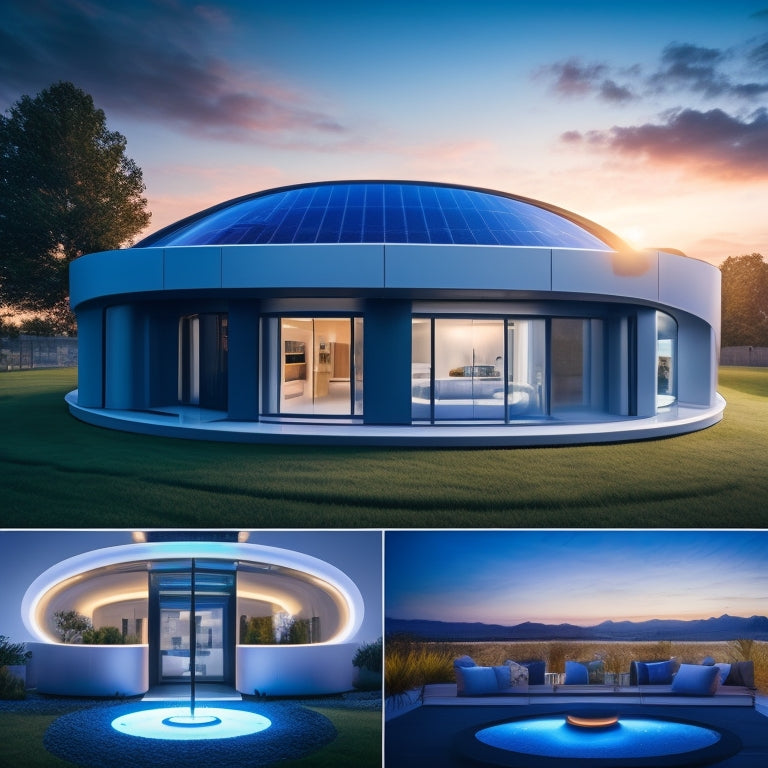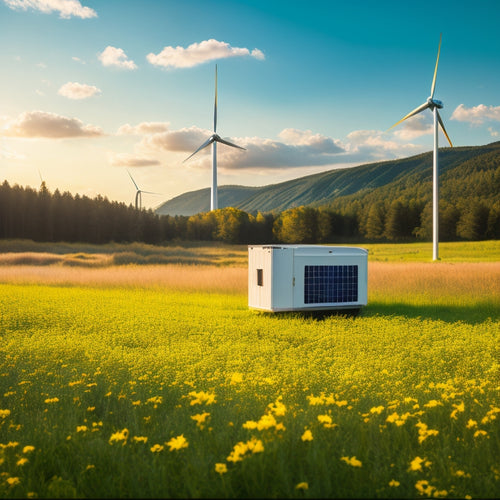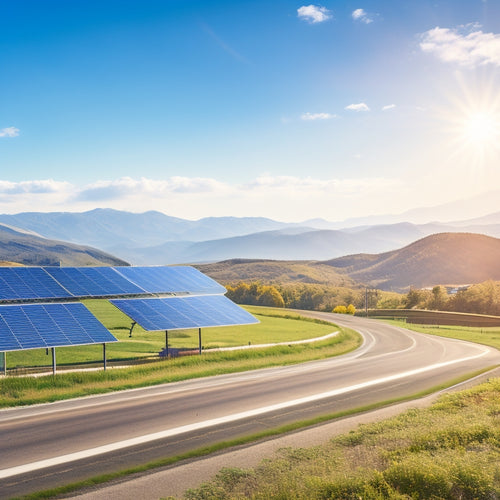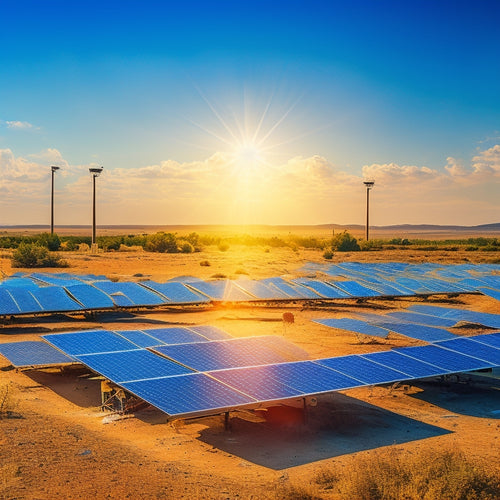
What's the Best Home Energy Storage Design?
Share
When designing a home energy storage system, you'll want to balance key components like energy capacity, discharge rates, cycle life, thermal management, and environmental impact to guarantee peak performance and minimize ecological footprint. You'll need to choose the right battery technology, considering factors like lithium's high energy density and long lifespan, or flow batteries' scalable capacity. System sizing and configuration are also vital, as is selecting the right inverter and integrating it with your solar panels. By balancing these factors, you can create an efficient and sustainable energy storage system that meets your needs - and that's just the beginning of your path to peak energy management.
Overview
- A well-designed home energy storage system balances energy capacity, discharge rates, cycle life, thermal management, and environmental impact considerations.
- Lithium batteries are a popular choice due to their high energy density and long lifespan, but lead acid and flow batteries have their own advantages.
- A comprehensive energy audit helps identify inefficiencies and optimizes energy usage patterns, ensuring the system is sized correctly for the home's energy needs.
- Efficient inverter technology, high-efficiency ratings, and smart inverter capabilities maximize system performance and minimize energy losses.
- Regular maintenance, including software updates and component replacements, is crucial to ensure the system operates safely and efficiently over its lifespan.
Key Components of Energy Storage
Your home energy storage system relies on several essential components to effectively capture, store, and deploy electrical energy.
You'll need to take into account the energy capacity, discharge rates, and cycle life of your system. Thermal management is also vital to prevent overheating and optimize performance.
When selecting a system, evaluate the environmental impact, warranty terms, and maintenance requirements to guarantee a hassle-free experience. Charge efficiency and installation costs are also key factors to take into account.
Understanding the lifespan expectations of your system will help you make an informed decision.
It's also important to note that deep cycle batteries, paired with a Battery Monitoring System (BMS) monitoring systems, can greatly enhance the overall performance and longevity of your energy storage system.
By accurately sizing your system and conducting an energy audit, you can identify inefficiencies and optimize your energy usage patterns.
Battery Technology Comparisons
With regards to energy storage, selecting the right battery technology is vital, as it directly impacts the overall performance, cost, and lifespan of your system.
You'll want to weigh the lithium advantages, such as high energy density and long lifespan, against the lead acid drawbacks, including low efficiency ratings and limited recycling options.
When evaluating battery options, it's essential to take into account the total cost of ownership, including upfront, maintenance, and replacement costs total cost of ownership, as well as the performance and maintenance requirements for ideal solar solutions.
Flow batteries offer a unique solution with scalable capacity, but solid state benefits, like enhanced safety and faster charging, are also worth examining.
When making a cost comparison, factor in lifespan, efficiency, and environmental impact.
Lithium-ion batteries have a higher upfront cost, but their longer lifespan and higher efficiency ratings make them a more cost-effective option in the long run.
System Sizing and Configuration
You'll need to determine the ideal battery bank design to meet your energy storage needs, taking into account factors like depth of discharge, round-trip efficiency, and cycle life.
When selecting an inverter, you'll want to evaluate criteria such as efficiency, power rating, and compatibility with your battery bank and grid connection.
It's also important to assess the integration of your home battery system with solar panels and smart home devices, ensuring seamless energy flow and enhancing energy management.
As you design your system, you'll also need to examine scalability options to accommodate future energy demands or upgrades.
Battery Bank Design
Designing a battery bank for home energy storage requires careful evaluation of system sizing and configuration to assure peak performance, reliability, and cost-effectiveness.
You'll need to select the right battery chemistry, as different types offer varying levels of efficiency, depth of discharge, and lifespan. For instance, lithium-ion batteries provide high energy density and long lifecycles, but may be more expensive.
Lead-acid batteries, on the other hand, are more affordable but have lower energy density and shorter lifecycles.
You'll also need to take into account discharge cycles, as this affects the battery's overall lifespan and performance.
Inverter Selection Criteria
Your home energy storage system's battery bank is only as good as the inverter that converts its DC power to AC for your home's appliances. When selecting an inverter, you'll need to take into account the type that best suits your system's requirements.
There are three primary inverter types: string inverters, microinverters, and power optimizers. String inverters are the most common, but microinverters and power optimizers offer greater flexibility and efficiency.
Inverter efficiency is critical, as it directly affects your system's overall performance. Look for inverters with high efficiencies, typically above 95%.
Additionally, take into account the inverter's compatibility with your battery bank and the system's overall configuration. By carefully evaluating these factors, you'll guarantee your inverter selection supports your energy independence goals.
System Scalability Options
With system scalability in mind, it's essential to evaluate the flexibility of your home energy storage design, as it will allow you to adapt to changing energy needs over time.
You'll want a system that can grow with your needs, whether that's adding more storage capacity or integrating new energy sources.
Modular expansion is key, enabling you to add or remove components as needed.
This flexibility also enables effective load management, ensuring that your system can handle peak energy demands while minimizing waste.
Power Conversion and Inverter
You'll need to take into account two vital aspects of power conversion and inverter design in your home energy storage system: efficient inverter technology and grid synchronization methods.
Efficient inverter technology is imperative to minimize energy losses and maximize the system's overall performance.
Efficient Inverter Technology
Inverters play an essential role in home energy storage systems, converting DC power from batteries or solar panels to AC power for household use.
When selecting an inverter, you'll want to prioritize efficiency to minimize energy losses. Look for inverters with high efficiency ratings, typically above 95%.
Smart inverters, which can monitor and control energy flow, are also a good choice. These advanced inverters can optimize energy usage, reduce waste, and even provide real-time monitoring.
Grid Synchronization Methods
Grid synchronization is the process by which your home energy storage system synchronizes its output frequency with that of the grid, guaranteeing a seamless changeover between grid-tied and off-grid modes.
This process is critical for demand response and load shifting applications, where your system must adapt to changing grid conditions.
You'll want to take into account two main grid synchronization methods: phase-locked loop (PLL) and grid-forming.
PLL synchronizes your system's output frequency and phase with the grid's, while grid-forming allows your system to take control of the grid frequency and voltage.
Both methods have their advantages, but grid-forming provides more flexibility and stability in islanded mode.
Energy Monitoring and Control
Three key components of a home energy storage system - sensing, monitoring, and control - work in tandem to optimize energy usage and storage.
You need real-time analytics to track your energy production, consumption, and storage. This data enables you to make informed decisions about when to store excess energy and when to draw from your reserves.
A sophisticated monitoring system can also facilitate demand response, allowing you to adjust your energy usage in response to changes in the grid.
With a well-designed control system, you can automate these processes, ensuring that your energy storage system operates efficiently and effectively.
Safety and Installation Considerations
Several essential factors come into play when designing and installing a home energy storage system, and safety considerations top the list. You must prioritize installation safety, guaranteeing that the system is installed according to local electrical codes and regulations.
Fire prevention measures, such as thermal monitoring and fire-resistant materials, are critical to prevent electrical fires. Regular maintenance is fundamental to guarantee system reliability and prevent equipment failure.
You should also consider the environmental impact of your system, choosing equipment with minimal waste and recyclable materials. Emergency preparedness plans should be in place, including equipment warranties and backup systems.
Frequently Asked Questions
Can I Use Energy Storage With My Existing Solar Panel System?
You can definitely integrate energy storage with your existing solar panel system, enabling solar battery integration benefits like reduced grid reliance and increased energy independence, while maximizing energy storage benefits like backup power and peak shaving.
How Long Does It Take to Charge an Energy Storage System Fully?
You'll find that the time it takes to fully charge your energy storage system depends on its charging efficiency and storage capacity; for example, a 10 kWh system with 90% efficiency might take around 11 hours to fully charge from a 9 kW solar array.
Are Energy Storage Systems Compatible With Grid-Tie Inverters?
You'll find that most energy storage systems are compatible with grid-tie inverters, but it's essential to verify the inverter's compatibility with your battery chemistry, as some inverters only work with specific chemistries, such as lithium-ion or lead-acid.
Can I Use a Single Energy Storage System for Multiple Homes?
You can share energy storage systems across multiple homes, achieving cost efficiency through shared systems, but be aware of installation challenges, increased maintenance requirements, and the need for advanced energy management and load balancing capabilities.
Are Energy Storage Systems Affected by Extreme Temperatures?
You face temperature extremes, and it's vital to know how they impact your energy storage system. Temperature effects greatly influence battery performance, making thermal management essential for ideal energy efficiency, ensuring your system operates reliably, even in the harshest conditions.
Ready to Buy
You've made it this far, and yet, you still don't have the perfect home energy storage design. Ironically, that's because there isn't one - at least, not one that fits every scenario. The best design is a delicate balance of battery tech, system sizing, power conversion, and monitoring. It's a puzzle that requires careful consideration of your unique energy needs and goals. So, don't worry, you're not missing out - you're just getting started on crafting your ideal energy storage solution.
Related Posts
-

Sustainable and Eco-Friendly Generators for a Reduced Carbon Footprint
Sustainable and eco-friendly generators are perfect for cutting your carbon footprint and increasing energy efficienc...
-

Is Switching to Green Energy Solutions Easy
Switching to green energy solutions isn't just easy; it's also beneficial. You can greatly cut utility costs and enjo...
-

What Happens Without a Charge Controller in Solar Panels
Without a charge controller in your solar panel system, you risk overheating batteries due to overcharging, which can...


